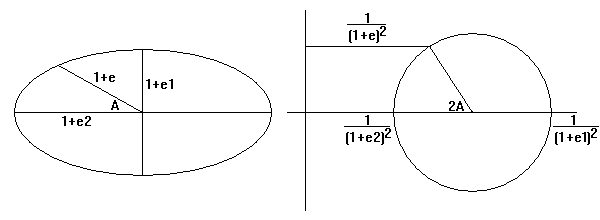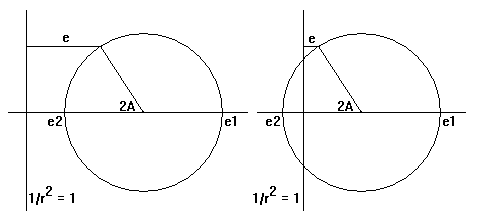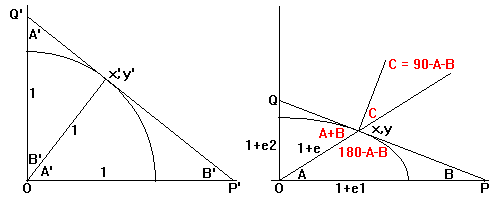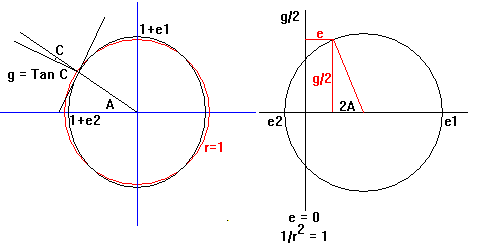Mohr Circles and Infinitesimal Strain
Steven Dutch, Professor Emeritus, Natural and Applied Sciences, University of Wisconsin - Green Bay
For general comments on Mohr Circles and ellipses, see Mohr Circles and Conic Sections
Infinitesimal strain is strain that is less than a few per cent. We can regard deformed circles as still pretty much circular, and can make use of certain useful mathematical approximations.

On the left we have an originally circular shape deformed into an ellipse. The strains (denoted by e) are tiny and the elliptical shape is highly exaggerated. In reality it would scarcely be distinguishable from a circle. On the right is the corresponding Mohr Circle. In reality, since e1 and e2 are small, the circle would be very tiny. Its size is exaggerated for clarity.
Now the radius terms 1/(1+e)2, and so on, can be approximated as series. 1/(1+e)2 = (1+e)-2 = 1-2e+3e2-4e3..... Thus we can:
- Approximate 1/(1+ e)2 as 1-2e. How big can e be before we have to account for higher-order terms? Depends on the application. For e = 0.01, probably no problem; for e = 0.1, maybe not.
- Shift the origin to radius = 1 and just graph -2e.
- Reverse the sign and graph 2e
- Change scale and graph in terms of e.
 |
Plot Mohr Circles for infinitesimal strain exactly the way we did for stress. The left example shows a case where strain is positive in both directions. The right shows the more likely case where one strain is positive and one negative. |
Note in the right example above, that, although e2 is negative, 1+e2 is still positive (because e2 is small). The strain is negative (length has contracted) but the length in the e2 direction is still positive.
The rules are not really different for finite and infinitesimal strain. It's just that for infinitesimal strain we can make use of some simplifying approximations. Plotted in terms of radius the Mohr Circle would be a tiny circle scarcely distinguishable from a point. The Mohr Circle for infinitesimal strain merely allows us to zoom in on the circle.
What About Shear?
We can begin with a diagram very much like the one we used to calculate finite shear strain. On the left is an original circle, on the right it has been very slightly deformed (deformation greatly exaggerated for clarity).

The circle has been deformed by a factor of 1+e1 in the horizontal direction and 1+e2 in the vertical. Thus
- OP = (1+e1)OP' and OQ = (1+e2)OQ'.
- Also x = (1+e1)x' and y = (1+e2)y'.
- Now Tan A' = y'/x' and Tan A' = y/x, so Tan A = (1+e2)/(1+e1) Tan A'.
- Likewise Tan B' = OQ'/oP' and Tan B = OQ/oP = [(1+e2)OQ']/[(1+e1)OP'] = (1+e2)/(1+e1)Tan B'
As with finite strain, the tangent to the ellipse is no longer perpendicular to the radius and the angle of change, C, is a measure of the shear.
- Tan C = Tan (90-A-B) = Cot (A+B) = 1/Tan(A+B) = (1 - Tan A Tan B)/(Tan A + Tan B). Since Tan A = (1+e2)/(1+e1) Tan A'. and Tan B = (1+e2)/(1+e1)Tan B', we have:
- Tan C = (1 - Tan A Tan B)/(Tan A + Tan B)
- = (1 - (1+e2)/(1+e1) Tan A' (1+e2)/(1+e1)Tan B')/((1+e2)/(1+e1) Tan A' + (1+e2)/(1+e1)Tan B')
- = ((1+e1)/(1+e2) - (1+e2)/(1+e1) Tan A' Tan B')/(Tan A' + Tan B'). Now Tan B' = Cot A' = 1/Tan A', so we have:
- = ((1+e1)/(1+e2) - (1+e2)/(1+e1))/(Tan A' + 1/Tan A')
- = [((1+e1)/(1+e2) - (1+e2)/(1+e1))Tan A']/(Tan2A' + 1). Recall that Tan2A' + 1 = Sec2A' = 1/cos2A' We then have:
- = ((1+e1)/(1+e2) - (1+e2)/(1+e1))Tan A' Cos2A', and since Tan A' = Sin A'/cos A', we have:
- = ((1+e1)/(1+e2) - (1+e2)/(1+e1))Sin A' Cos A'. Now 2 Sin A' Cos A' = Sin 2A', so we have:
- = ((1+e1)/(1+e2) - (1+e2)/(1+e1))/2 Sin 2A'
Now we need to attack the strain terms: We have:
- Tan C = ((1+e1)/(1+e2) - (1+e2)/(1+e1))/2 Sin 2A'. Now 1/(1+e) = 1 - e + higher power terms, so we can approximate Tan C as
- Tan C = ((1+e1)(1-e2) - (1+e2)(1-e1))/2 Sin 2A'
- = ((1+e1-e2-e1e2) - (1+e2-e1-e1e2))/2 Sin 2A'. Since the e's are tiny, the product terms are negligible, so we have
- = (e1 - e2 - e2 + e1)/2 Sin 2A'
- = (e1 - e2) Sin 2A'
The trick in using approximations is knowing when to apply them. We could have applied the approximation that strain is tiny to the factor (1+e1)/(1+e2) - (1+e2)/(1+e1), to get 1/1-1/1 = 0, with the resulting approximation that Tan C = 0. Now that is true - Tan C is small and for some purposes we might well assume it is zero, but it's no good if we want to estimate Tan C itself.
Now the radius R of the Mohr Circle is (e1-e2)/2 so we have Tan C = 2R Sin 2A'. Tan C is usually represented by the Greek letter gamma. For the sake of those without fancy type fonts we'll use g here. We have g = 2R Sin 2A. In other words, the vertical coordinate on the Mohr Circle for infinitesimal strain represents g/2.
Again, the rules are not really different for finite and infinitesimal strain. It's just that for infinitesimal strain we can make use of some simplifying approximations.
 |
On the left is a circle (red) deformed very slightly into an ellipse. On the right is the corresponding Mohr Circle. Note that e2 is negative so the ellipse is shorter in the e2 direction. |
Return to Course Syllabus
Return to Techniques Manual Index
Return to Professor Dutch's Home Page
Created 29 November 2000, Last Update 1 December 2000